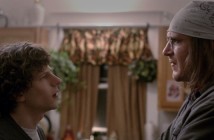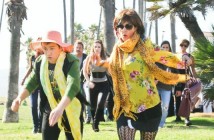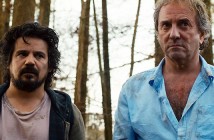Night on Earth (1991)
Cast: Winona Ryder, Gena Rowlands, Lisanne Falk
Director: Jim Jarmusch
Country: France | UK | Germany | USA | Japan
Genre: Drama | Comedy
Official Site: Here
Editor’s Notes: The following review is part of our coverage for TIFF’s Strange Paradise: The Cinema of Jim Jarmusch. For more information on upcoming TIFF film series visit http://tiff.net and follow TIFF on Twitter at @TIFF_NET.
For all their style, the source of the greatness in the films of Jim Jarmusch is not aesthetic, but conversational. Yes his oddball characters travel through some beautifully framed environments, but it’s the often mundane, ever-poignant banter that sets his films apart. Two Mafiosi discuss the contradictions of chivalry and feminism in Ghost Dog. Two vampires discuss post-industrial urban decay in Only Lovers Left Alive. Musician Jack White discusses a tesla coil with his ex-wife in Coffee & Cigarettes.
Jarmusch’s 1991 film Night on Earth is all about conversations between people who meet by chance; however scripted, you feel as though you’re listening in on a private interaction that is both insignificant and life-altering. More importantly, those conversations come to define the time and place where they occur. It’s a secondary matter that they all take place inside of taxis.
Jarmusch’s 1991 film Night on Earth is all about conversations between people who meet by chance; however scripted, you feel as though you’re listening in on a private interaction that is both insignificant and life-altering.
Made up of five vignettes set in (and around) taxis on the same night in five different cities, it’s hard to review one’s thoughts on the film without critiquing each segment separately. The first is set in Los Angeles, with tomboyish cabbie Winona Ryder taking casting agent Gena Rowlands to Beverly Hills, leaving an impression on the exec with her spunky charm. The second, in wintry New York, sees out-of-his-depth East German immigrant Armin Mueller-Stahl being shown how to run his vehicle by frustrated passenger Giancarlo Espositto on a long drive to Brooklyn. In Paris, Jarmusch muse Isaach De Bankolé plays a racially abused Ivorian taxi driver who finds himself offending his fare, a blind woman played by Béatrice Dalle. In Rome hyperactive eccentric Roberto Benigni converses with himself oblivious to the sensitivities of his passenger, a priest (Paolo Bonacelli). And in Helsinki a weary late night cab ride finds Aki Kaurismäki regular Matti Pellonpää comparing personal tragedies with his three inebriated clients.
The segments are hit and miss, wavering between comedy and tragedy, with some segments heavy on both. The Los Angeles sequence is curiously the most dated, with Ryder’s cabbie of that careless slacker variety that could only exist in the decade between The Breakfast Club and Clerks (Rowlands’s mobile phone is also hypnotically prehistoric). Emphasising the place of women in contemporary America, with two confident women making their ways in two very different male-dominated businesses, this LA story can’t quite get its point across without stooping to gender clichés – Ryder calls Rowlands “mom” twice, sarcastically, while the pair also discuss the kind of family Ryder may have in future; all boys.
The New York segment is the strongest, with a remarkable rapport between Mueller-Stahl and Espositto. Espositto is the streetsmart local whose frustration belies his goodness. Mueller-Stahl’s character is a former circus clown who doesn’t realise the joke is over. The energy between the pair slows down when they stop to pick up Espositto’s sister-in-law, played by Rosie Perez, but its snapshot of New York as an imposing city where anything is possible, but only with enormous effort, rings eternally true.
Playing with a character who is literally colourblind, the Paris segment examines ideas of race and perception with a great deal of wit, but no huge insight. “Don’t blind people usually wear glasses?” De Bankolé asks Dalle. “I wouldn’t know, I’ve never seen a blind person,” she replies with startling confidence and bite. There’s a cool air of sexual tension between the pair that doesn’t quite pay off by the vignette’s end, but its assertion that two naturally disenfranchised strangers don’t necessarily need to see eye-to-eye, so to speak, makes it a nice little antithesis to the PC equivalent a major Hollywood studio might have made with this tale.
Night on Earth is a mixed cab of tricks, full of clever little moments that never add up to anything superb together. It could have been so much more.
While the Rome chapter is perhaps the most finely shot, taking in the gold and blacks of the city’s empty streetlighted alleys in the early morning, it is by a good measure the weakest of the lot. Benigni is largely insufferable as an extended version of his usual frantic role, but without the same likeability. At first driving in circles rabbiting on to himself, he soon embarks on torturing his frocked passenger with an absent-minded tirade about his various (and deviant) sexual congresses. More than 20 years later, giving a priest such a hard time seems less cruel in the wake of years of Catholic scandals, but coming from 1991 the scene comes off as mercilessly mean-spirited. It’s black comedy, but without the laughs.
The Helsinki segment is a troubling coda to the film, although a strong short in its own right. Featuring a far less metropolitan city (a fraction the size of Paris or Rome and hardly a neighbourhood’s worth by NYC or LA standards), the vignette gives off no small sense that Jarmusch had been watching a lot of Kaurismäki movies and wanted to make his own. Pellonpää is stoic and morose as the driver worn out by his personal slings and arrows, while his drunken customers fluctuate from stumblingly comic to awkwardly depressed as the story progresses. It ends the movie on a downer even with a new dawn approaching.
There is no major theme running across the stories, other than examining the seemingly inconsequential but perhaps life-altering effect a chance encounter that is never to be repeated can have on people. However the comparisons between the cities are interesting to observe, especially between the two continents. The broad boulevards of the American cities contrast finely with the dark, narrow, winding medieval passages of the Old World. The gloomy Finn could not be more different to the Roman jack-in-the-box, yet they live surprisingly similar lives in identical roles.
With the film opening with Tom Waits’s pluckily sullen ‘Back in the Good Old World’, it’s hard not to feel that a night on Earth has been denied the viewer. Five cities on only two continents leaves much of the world unaccounted for, and only those amongst the most well off of the planet’s inhabitants. A decade later Abbas Kiarostami would make Ten, another film made up of vignettes set entirely in a taxi. But, set in Tehran, and with an overarching focus on the roles and perceptions of women in Iran, it revealed far more universal truths about the world we inhabit than all of Jarmusch’s globe-hopping.
Night on Earth is a mixed cab of tricks, full of clever little moments that never add up to anything superb together. It could have been so much more.
With one excellent segment, three very good ones and one poor, Night on Earth is more hit than miss, but the film as a whole is less than the average of the vignettes. The cities are well captured on film and the clever conversational dialogue mostly engages, but with no unifying theme beyond “cab ride”, the film fails to achieve the greatness its ingredients allow for.




